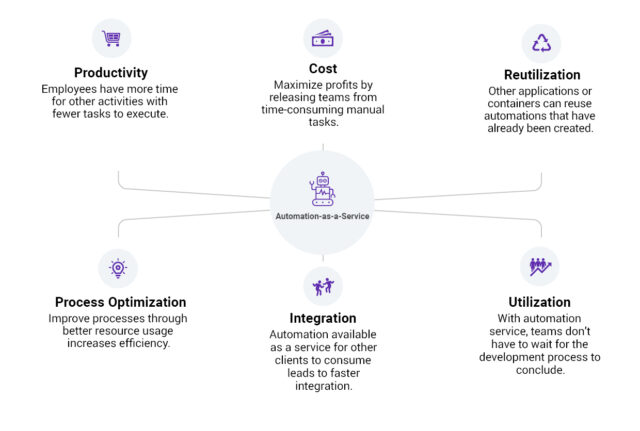Artificial intelligence is a rapidly growing field with applications across industries, focused on creating intelligent machines that can perform tasks typically requiring human intelligence. Transformation in technology, including the burgeoning field of AI, has delivered ever-increasing value to our digital world, and it would be hard to imagine life without it. However, advancements in technology also create complex ecosystems with numerous dependencies. In order to keep complex ecosystems running with high availability and zero business impact, many still require human intervention to monitor and support around the clock. As ecosystems grow in scale and complexity, larger teams often become necessary to provide support. Furthermore, there are other IT challenges that organizations must address such as manual processes, cybersecurity threats and legacy systems, among others.
This is where automation can play a beneficial role and be a game changer for IT and business organizations. By leveraging automation technologies and implementing robust security measures, organizations can become more efficient, secure, agile and better positioned for business success. Automation-as-a-Service is a concept that involves providing automation solutions as a service to businesses. It integrates automated solutions for a staggering number of use cases – quickly and efficiently. This allows businesses to easily implement automation without the need for significant investment or technical expertise.
When Should we Automate?
Automation can vary in scope from simple scripting to fully autonomous systems. Typically, repetitive tasks like manual work require a lot of time to complete or are mission-critical for the company and cannot risk human errors. These tasks are good candidates for the lowest level of automation, which involves the use of programming languages.
Semi-autonomous automation involves the use of machine learning algorithms and other advanced technologies to automate more complex tasks. Humans still play a role in supervising automated processes, but the system can make decisions and take actions on its own based on pre-defined rules.
On the other hand, fully autonomous automation involves systems that can operate independently without any human intervention. This type of automation requires advanced AI and ML technologies that can learn and adapt to changes.
The extent of automation that is appropriate for a particular task depends on many factors, such as available technologies, complexity of the task and level of human oversight required. In some cases, a combination of different levels of automation may be used to improve efficiency and reduce errors. While these technologies can be incredibly powerful and effective, it is important to mention they are not fail-safe, and human oversight and intervention are necessary to avoid unexpected behavior.
What’s Next? Automation as-a-Service
When organizations have a team or multiple teams that create automation, we usually see similar automation requests from different IT and business teams. Instead of creating one-off automation processes for each individual team, organizations should consider automation-as-as-Service.
To get started, it’s important to define your automation goals and identify the manual processes you want to automate. This will help determine which automation tools to research and analyze for their features and ability to be offered as-as-Service. Afterward, consider build your automation workflows by developing a set of automations you can easily integrate for your clients. That way, they can quickly and easily begin seeing the benefits of your automation-as-a-Service offering.
When you develop and deploy one automation in production environments, observability is a key aspect to include as part of automation lifecycle management. This is also a useful practice to identify bugs not found during the testing phase. With monitoring, the automation team can identify issues more proactively than waiting for the business team to report them. The goal is to expand automation utilization, though customers need to trust it works as designed.
Embracing a services-oriented approach to your own IT delivery also brings many benefits to organizations.
While we recognize what organic IT teams can accomplish, there may be limits to what they can handle on their own, not to mention the difficulty in finding and hiring qualified employees to support a growing workload. To address the IT challenges, it is also important to find a balance between IT workload and automation processes to ensure employees can maintain a healthy work-life balance.
Furthermore, adding different products can aid in automation. For example, ChatGPT can enable different automation capabilities quickly and efficiently. ChatGPT can be used in conjunction with automation-as-a-Service to provide natural language processing, text generation capabilities, content creation, e-mail automation, sentiment analysis and more. It’s a valuable tool for automating routine tasks and improving customer experiences through automation-as-a-Service.
Unlock the Power of Automation and Take Your Business to the Next Level with Automation-as-a-Service
Automation is quickly transforming the way we work, and this trend will only continue. With the development of AI and ML, many tasks that were once exclusively in the domain of humans will soon be automated. This will lead to a shift in the nature of work, with a greater emphasis on tasks that require human skills such as critical thinking, emotional intelligence and creativity.
Organizations should consider having one or more dedicated automation teams. Automation professionals are responsible for solving complex problems in many aspects of the industry.
Automation is a key process for company success, and offering automation-as-a-Service delivers automation options and dynamic approaches that improve day-to-day work, drive business and create a fruitful environment for innovation.
Are you ready to take your business to the next level? Embrace the power of automation-as-a-Service today and streamline your operations like never before. Learn more in a recent white paper.



